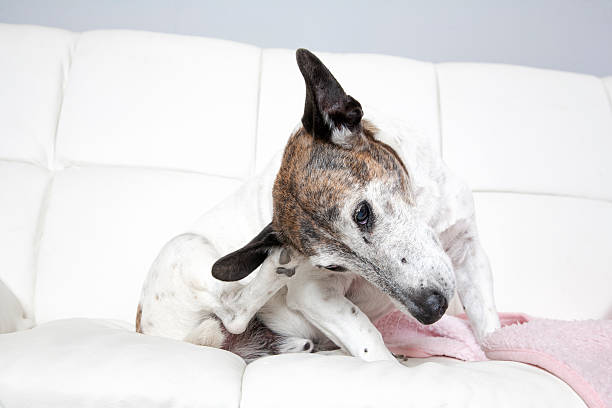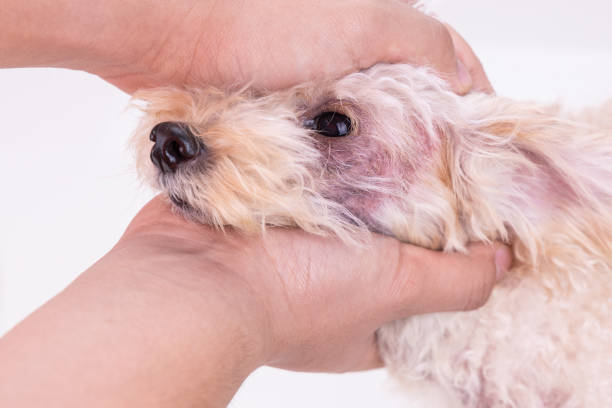Keep in mind, your dog doesn’t possess the capability to pick up a toothbrush and clean its teeth. Nonetheless, it’s crucial that you establish and maintain a weekly brushing routine for them. You could start this dental hygiene practice when they are no less than three months old. Similarly to humans, dogs can also experience plaque build-up on their teeth, which can lead to tartar formation and bacterial growth causing gingivitis.
Your Dog’s Teeth are a Dental Detective’s Dream
Humans have to rely on our dentists asking how often we floss or if they notice white buildup when checking our teeth with the dental mirror. With dogs, they are just like having a personal detective in your home! If your dog’s teeth or gum line are red, inflamed, or swollen, they may have tooth decay and should see their veterinarian.
Your furry family member will show visible signs and symptoms if any issues arise with their dental health, such as:
Oral Discomfort
Some dogs may shake their head, whine or show decreased appetite when there is a problem with their oral cavity. This is because of pain or discomfort that occurs when there’s an infection in the gums.
Grooming Difficulties
As mentioned, gum disease can cause redness and inflammation, which will not only be visible by looking at your canine friend but also you may notice they are brushing their teeth more often than usual. The plaque and tartar buildup on their teeth make it very difficult to groom themselves, leading to more severe issues such as infections or abscesses.
Bad Breath
If your dog’s breath smells like chemicals, chances are they may have an infection in the gums. This is also a sign of inflammation which can cause ulcers to form in the mouth. If your dog breathes through its mouth often, it could be because of overcrowding, which can cause discomfort and halitosis, but you should discuss this with your veterinarian.


Sensitive Teeth
If your canine friend suddenly stops eating hard kibble or food requiring a little bit more crunch, they may have tooth pain or sensitivity. This is because the bacteria on the surface of their teeth has caused an infection, which damages the enamel and causes bleeding when eating hard foods.
Facial Swelling/Drooling
If you notice swelling around your dog’s mouth or excessive drooling, this can be another sign that they may have an infection from a tooth that is either decayed, cracked, or required root canal therapy.
Sluggishness/Change in Vocalization
Your dog’s bodily functions and behaviour will change if they are experiencing a dental emergency such as pain, discomfort or infection. They may be less playful due to their ailment, which can cause depression or lethargy. If they are not responding to you the same way they usually do, it is a good idea to take them to a veterinary dentist as soon as possible because this means that they’re in pain and need treatment right away.


Quick Guide
You must know that their dental health is just as important as yours, but it can be challenging to figure out what needs fixing or what doesn’t. This quick guide will help you identify the signs of a dog’s dental problems and, hopefully, help prevent any future issues before they arise!
- A white film on your dog’s teeth could mean plaque buildup. Plaque can lead to tooth decay, leading to pain and infection. It may seem like an easy fix at first (brush your pup’s teeth), but this problem will only worsen over time without professional treatment.
- Your pup may have red gums if they have gum disease or gum recession because of too much tartar buildup. This can lead to further problems such as tooth loss, bone damage, and an increased chance of heart disease.
- A dull coat could indicate nutritional deficiencies due to malnutrition or even periodontal disease, which will cause bad breath and sickness if left untreated.
- Your dog might drool excessively or refuse food if their teeth are infected or painful to chew on.
- Excessive paw licking or chewing, ear infections, and even body odour can indicate tooth decay or severe dental problems.
- Your pup’s breath smells terrible! Well, he has a reason for it. If your dog’s mouth is loaded with bacteria (from plaque and tartar buildup between the teeth), it will cause bad breath.
- If you notice any of these signs, don’t hesitate to contact your vet! They’re trained to diagnose and treat this issue. Blood work might be needed before treatment to ensure everything’s okay with their overall health, but once it is, get ready for a happy, healthy pup.


Brush your dog’s teeth every day to prevent plaque buildup and tartar. Have a vet or veterinary dentist check them for serious problems. You can even brush their teeth for them.
In Summary…
If you’ve noticed any of these symptoms or behaviours from your canine friend, you should take them to a veterinarian immediately. You can help prevent further damage by brushing their teeth once a week, but seek medical attention immediately if you notice these signs!
If they are diagnosed with tooth decay or gum disease, your vet will most likely recommend having the tooth extracted if it can’t be cleaned at home or is very badly decayed. If the infection is not treated, they will most likely see an increase in these symptoms that you have just read about.
You can find a veterinary dentist by asking your regular veterinarian where they send their patients or by looking through your local phonebook for animal clinics. Like humans, dogs can also suffer tooth loss, but this doesn’t mean they will lose all of their teeth! They will most likely be uncomfortable, and your vet can provide you with some options.
Cleaning your dog’s teeth is just as crucial for them as it is for us humans! Veterinary dentists are trained to clean your pet’s teeth so they can live a long healthy life.


